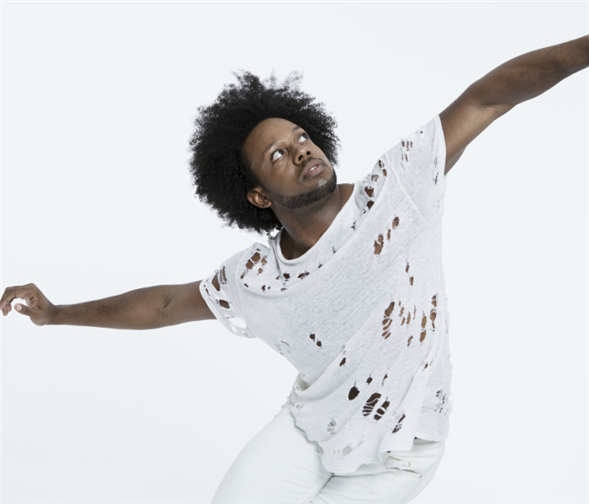Translate Page

From new work to vital spaces, Gina Gibney offers the dance world a rich array
---
Gina Gibney wears so many hats that when she wants to create a new work, it seems it might be difficult for her to focus on choreography. After all, her Gibney Dance Center has been expanding in size, ambition, and range of activities over the past five years, and she's now responsible for two major venues that offer rehearsal space, classes, performance series, and community action projects.
If time management is a challenge, however, she doesn't show it. She discusses budget figures, scheduling logistics, and fundraising details as enthusiastically as she talks about finding the music for Folding In, her new work which runs November 2-12 at the Center.
Not every choreographer proclaims, "I enjoy grant writing and fundraising," but in Gibney's case, those skills have certainly come in handy. Gibney Dance, which turns 25 this year, long operated out of a rented studio on the fifth floor of 890 Broadway -- the historic Flatiron District building that is home to numerous performing arts companies. When she wasn't rehearsing her dancers there, she rented it out -- offering regular ballet classes, providing other choreographers with space -- to help meet the costs.
Then, a little over five years ago, things changed on the fifth floor. "When various tenants left, I started to realize it would actually be a wonderful thing for the dance community to have that space -- and that it also might help the organization to have a more efficient financial model," Gibney says. Even though expansion had not previously been on her mind, she decided to take the plunge.
Over the course of 2011, the entire floor -- eventually eight studios -- became her responsibility. She launched her expanded enterprise as Gibney Dance Center, an integrated complex of studios and resources designed with the goal of "making space for the future of dance."
"It's studios, programs, residency space for the contemporary dance community," she says. "We created a successful model with really being very vigilant about space utilization -- and also renting a small percentage of the time to Broadway [productions] at premium rates."
In late 2013, she was contacted by the New York City Department of Cultural Affairs (DCA). Dance New Amsterdam, a longstanding organization that offered classes and presented performance series, had been facing financial difficulties and eventually went under, leaving the fate of its space at 280 Broadway in doubt.
Credit the city with wanting to maintain the venue for the performing arts, otherwise it might easily have been developed for commercial use. Having noted what Gibney was already doing, DCA felt she was the one to take over the lease. "I think they initiated this because of the success of 890, and the financial model we pioneered there," she says. "And also because of its inclusivity. They wanted to see if we could do it here. It was a lot, though. It's a huge challenge. Of course I hesitated. But something had to happen. Having been in this field for decades, I've seen so many dance studios fall by the wayside. So many spaces along lower Broadway ended up being repurposed for other real estate. Once you lose a space that's been invested in, it's a tremendous loss."
She took on the second venue, and her vision for Gibney Dance Center expanded along with the square footage. The eight studios at 280 Broadway are in constant use, as the bustling activity in the hallways on a recent visit made clear. "If there's not a class, there's a rehearsal," Gibney says. "There's something going on. They're full morning to night."
There's a primary performance space -- a black box theatre -- and two of the studios double as performance venues. Gibney chose the large second-floor studio for performances of Folding In. She envisions the setting for her new dance as a white box. "I wanted to keep it simple -- maybe because my life is so complicated!" she says.
The piece is set to an atmospheric score in 11 sections with shifting moods, by Icelandic cellist and composer Hildur Guðnadóttir. "I always work from a core image or theme. I started to think about the notion of how life offers these opportunities where you extend yourself -- physically, psychologically, emotionally, spatially," Gibney says. "I wanted to explore a sense of spatial expansiveness, how you learn and grow, and then how you return and find solace inside of yourself."
This is Gibney's first new dance work in three years. Her last premiered just as the idea of taking over at 280 Broadway was broached. "I've been making dances long enough that when I go into the studio I'm comfortable," she says. "Thankfully, I can close everything out."
She's clearly finding balance, and great satisfaction, in the larger, more diversified dance organization she now helms. "For decades, I felt we were doing well just by maintaining our model, staying solvent, and keeping our one studio," she says. "It's just been extraordinary to see what happens when you get the wind at your back. It's really been an incredible experience. I think there's so much more that we can do. I think the dance field really needs organizations like this that are bringing people together, creating space for people to meet and work together, and have experiences that help them grow as artists."
--
Susan Reiter regularly covers dance for TDF Stages
Performance photo by Julieta Cervantes. Photo of Gina Gibney by Christopher Duggan.
TDF Members: Go here to browse our latest discounts for dance, theatre, and concerts.